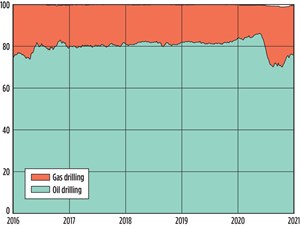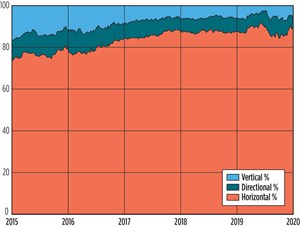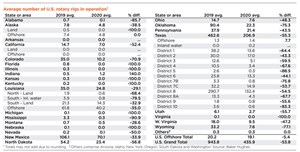Special Focus: 2021 Forecast & Review – U.S. Rotary Rig Count
Based on World Oil’s calculations, 2020 was the worst drilling year in the U.S. since 1898. Our tally shows only 11,581 wells were drilled in 2020, the lowest total since the 8,644 drilled in 1898.
The average U.S. rig count for 2020 was 436 units, a 53.8% decline compared to the previous year’s average of 944. Starting in January, the rig count averaged 791, but fell seven consecutive months to 250, after Covid-19 decimated demand. U.S. activity fell to an all-time low of 244 rigs the week of Aug. 14, but staged a modest recovery, ending the year at 351 in the final week of December.
Oklahoma and Wyoming suffered major activity declines, with both states losing approximately 75%, y-o-y. In Texas, all 12 RRC districts experienced a deterioration in activity, with a statewide decline of 255 rigs in 2020, a drop of 55%. In the Permian, RRC District 8 and RRC District 7C both suffered a 54% setback in activity. In New Mexico’s Permian, activity declined just 34%, as operators continued working the Bone Spring.
North Dakota did not suffer as much as other shale regions, but it still lost 57% of its active rigs to average 23 units in 2020.
In the northeastern U.S., operators working the Marcellus-Utica plays reduced activity but not as drastically as in the oil plays. Escalating prices for natural gas in the second half of 2020 mitigated losses in Pennsylvania, which was down 44%, to average 21 rigs in 2020. A similar scenario unfolded in West Virginia and Ohio, where operators working the Marcellus-Utica decreased rig utilization 47% and 48%, respectively, in 2020.
Target/trajectory split. The overall ratio of rigs targeting gas versus those drilling for crude oil shifted noticeably in 2020. In January, approximately 76% of rigs were targeting oil, with 16% seeking gas. By December, the gas rig tally was 24%. In 2020, the split between trajectories remained relatively stable. During 2020, 86% of all wells drilled in the U.S. were horizontal, with the remaining 14% essentially split between directional and vertical wells.
With the large investment required for offshore drilling and production, operators continued to maintain producing properties in 2020, but at a slower pace.
- The last barrel (February 2024)
- E&P outside the U.S. maintains a disciplined pace (February 2024)
- U.S. producing gas wells increase despite low prices (February 2024)
- U.S. drilling: More of the same expected (February 2024)
- U.S. oil and natural gas production hits record highs (February 2024)
- Rig electrification drives down emissions, bolsters efficiency while improving onshore drilling economics (October 2023)





